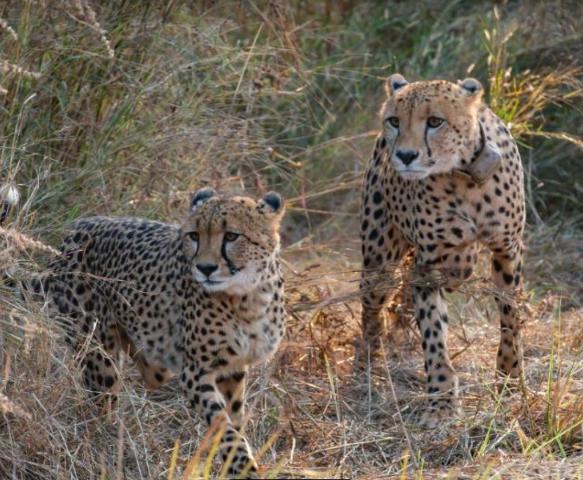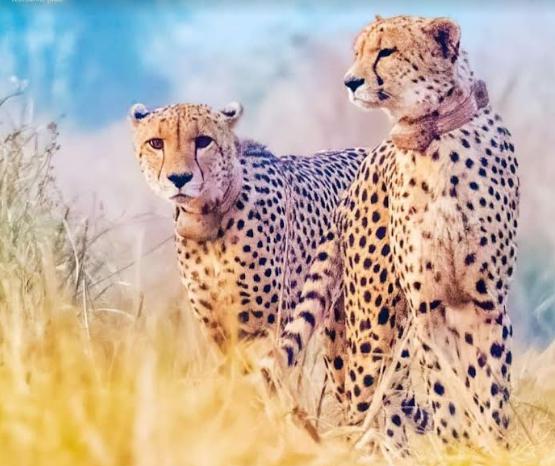"Cheetahs Unhappy In Enclosures"
In the first lot of Cheetahs that were brought from Namibia , there were 8 cats. Four were released in the open forest, one of them , Oban or Pawan, was brought back after it continued to move out. One female, Sasha, died on March 26. Three females are still in enclosures. After the latest cheetah casualty, there are 11 left from the lot brought from South Africa in February this year. It means there are 14 cheetahs remaining to be released in the open forest of Kuno, an issue staring at the officials of the cheetah project .After Sasha’s death because of kidney failure, the South African cheetah believed to have died because of stress caused by prolonged confinement. The 12 South African cheetahs were captured 9 months ago. There was a delay in the sighing of MoU leading to continued confinement in enclosures. If Uday , the cheetah that died on April 23, was under stress, so could be the remaining 11. South African experts involved in the translocation recommend their release in the wild.
Also read: Tiger In Chain, Arunachal Forest Minister Goes For Walk
Uday was suffering from chronic stress, South African cheetah expert Vincent Van Der Merwe said after his death. Merwe is the head of the metapopulation project and caught the cheetahs for translocation. “Like the 11 others, he was a wild cheetah. He was very healthy before shifting to Boma in July 2022 for the translocation project. After 10 months in captivity, he lost fitness and suffered from chronic stress,” Merwe has been quoted in the Hindustan Times . He said that the animals must be released in the wild. “The cheetahs must go back into the wild where they belong. They are unhappy in cages,” he said.
Look For Second Home
Oban’s adventures seemed to have forced the state forest department of Madhya Pradesh to think twice to release the remaining cheetahs in Kuno. Imagine the plight of the field workers both Indian and those from Namibia tracking the cheetahs in the jungle. They chased Oban or Pawan beyond the boundaries of Kuno when the cat had reached the adjoining districts as far as 100 kms away from Kuno. Carrying equipment to track the animal, a team of 9 to 10 people had a tough time. If 14 more are released, it would require about 140 more people to track the animals 24X7. They should also be equipped with drones, vehicles, wireless sets among other things. Also imagine the noise created by the drones and the movement of so many people inside the jungle while tracking the animals.
Also read: Another Cheetah Dies in Kuno ,Will Post Mortem Report be Made Public
The government requires doing two things as soon as possible. The second home for the cheetah is the need of the hour. Besides, about 4000 sq km area around Kuno bordering Rajasthan and Uttar Pradesh needs to be developed as a cheetah landscape. And for doing this, the government needs to show a political will as this would require certain restrictions for the conservation of the iconic species. The cheetah action plan also said that more cheetah populations are required to be developed. The idea was to develop 3 to 5 separate cheetah populations. As per the Cheetah Action Plan - Kuno by itself is not viable for the long-term as the site is not big enough to have a viable population and for that you need atleast 3 populations and then move cheetahs between them as a managed meta- population that is the vision of the cheetah project.
Also read: Adventures of Asha, Oban Put Cheetah Task Force in a Fix
Gandhisagar Wildlife Sanctuary spread across Mandsaur in Madhya Pradesh and Chittorgarh in Rajasthan and Nauradehi in Damoh and Sagar districts of Madhya Pradesh were also selected as the second home but it would not only take time but huge sums around Rs 300 crore to Rs 400 crore to develop each of them . This would include the development of grasslands, prey base and shifting of villages. But the best possible available and ready site for cheetahs is Mukundura. With grass lands in between, this mountainous jungle has a variety of trees and animals. In fact, cheetahs were to be brought first to Mukundura but Kuno was given preference by the Union ministry of environment, forest and climate change .




Comments
Post a Comment